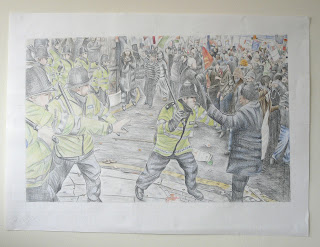Friday, 16 December 2011
Jam Sandwich
Sunday, 11 December 2011
Meat Wagon
Labels:
anarchy,
artist,
authority,
drawing,
lowbrow,
police,
pop,
riots,
stencil,
street art,
van,
vandalism
Saturday, 10 December 2011
Wednesday, 7 December 2011
Monday, 5 December 2011
Sunday, 4 December 2011
Wednesday, 16 November 2011
Tuesday, 15 November 2011
Monday, 14 November 2011
Sunday, 13 November 2011
Saturday, 12 November 2011
Friday, 11 November 2011
Thursday, 10 November 2011
Tuesday, 1 November 2011
Friday, 28 October 2011
Thursday, 27 October 2011
Tuesday, 25 October 2011
Friday, 9 September 2011
Wednesday, 17 August 2011
Monday, 15 August 2011
Sunday, 14 August 2011
Monday, 1 August 2011
Britney as a Mythical Greek Goddess from Antiquity, a Step by Step Tutorial in the Creation of an Ancient Work of Art
Stage One. The drawing is transferred onto the plaster surface
Stage two. The lightest tones are applied first leaving the areas unpainted that will remain white, the whole process is painted from light to dark (chiaroscuro).
The colour is applied in very fluid mixtures, which should soak into and become part of the plaster, as appose to sitting on the top of the surface. This process does not allow you to remove or cover over mistakes, and is very similar to watercolour painting.
The painting stage is complete; the next stage will be an exercise in accelerated ageing, an attempt in faking a relic from antiquity.
Labels:
antique,
art,
artist,
Britney Spears,
culture,
drawing,
fake,
fresco,
jigsaw,
painting,
pop,
relic,
tutorial
Location:
Canterbury, Kent, UK
Saturday, 30 July 2011
From Britney to Antiquity, Part two. A Step by Step Tutorial in the Creation of an Ancient Work of Art
Using various tools the painting is ‘vandalised’ by adding various scrapes, scratches and gouaches, with particular attention towards the edges.
The painting is broken into pieces, creating an interesting jigsaw.
The individual pieces are brushed with a mixture of emulsion, English Tea and water. The tea stains the white edges and gives the impression of age, and the emulsion helps seal the plaster.
The painting is mounted onto a backing plate that is smaller than the picture, which shows off the rough edges by projecting an interesting shadow onto the wall.
Tuesday, 12 July 2011
Will cuts to funding the arts in the UK result in a return to the importance of skill and craft? Highbrow versus the Lowbrow
As tuition fees saw up to nine grand a year, and contact time with academic staff becomes rarer and rarer, will this create a backlash to current trends of anti-craft and dismissal to talent and skill? As art students are taught by the second generation of academics, who were not taught how to make art themselves, what can be the near future for Fine Art? When only the higher middle and wealthy members of society can justify the costs of studying art within a recognised institution, who will suffer in the end, the artist or the institution? I don’t know of many cultural movements that didn’t start at root level and work upwards, consider the origins of hip-hop, punk, disco music, and the effects and popularity these sub-cultures have had on contemporary society.
Art students on a whole today are self taught, learning through self determination and peer interaction. Art schools act as a hub to bring in a diverse group of thinkers eager to learn and make an impact within society, through interaction and academic guidance they can better understand their lives and the possibilities of future paths for a society, through cultural studies. Hip-hop, punk and disco had/has energy channelling anger, bringing people together through a shared interest, no matter the race, age or social standing they are now part of mainstream popular culture, but they all started in the poor and (dangerous) urban areas, not in leafy suburbs and gated communities.
What is more interesting and or authentic, a gigantic ‘abstract’ sculpture designed by somebody in a position because of who they know, and commissioned by a profit lead oil company, or a cleverly thought out but simple detourned piece of advertising?
Saturday, 9 July 2011
Thursday, 7 July 2011
Thursday, 30 June 2011
eleven: Introductions.
eleven: Introductions.: "Welcome to the blog for the art group eleven . Formed of fresh new fine art graduates from University of the Creative Arts, Canterbury. ..."
Tuesday, 21 June 2011
Tuesday, 14 June 2011
Sunday, 12 June 2011
Friday, 10 June 2011
Tuesday, 7 June 2011
Sunday, 5 June 2011
Thursday, 2 June 2011
Tuesday, 31 May 2011
Sunday, 29 May 2011
Saturday, 28 May 2011
Thursday, 26 May 2011
Subscribe to:
Comments (Atom)















































